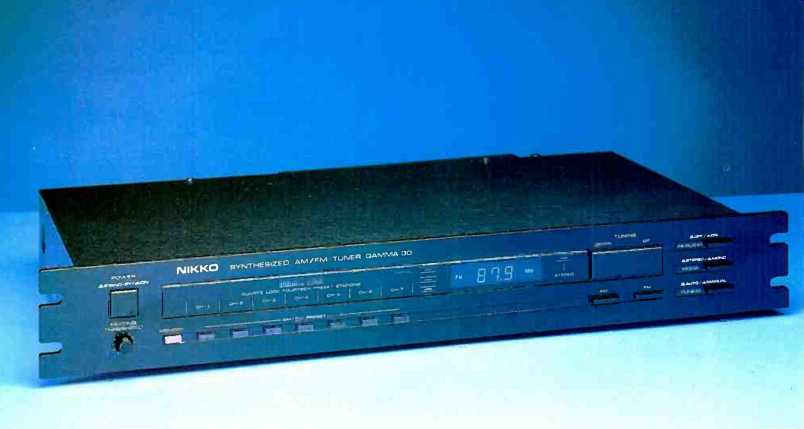
Manufacturer's Specifications:
FM Section:
Usable Sensitivity: 11.2 dBf.
50-dB Quieting Sensitivity: Mono, 14 dBf; stereo, 20 dBf.
S/N Ratio: Mono, 70 dB; stereo, 67 dB.
THD: Mono, 0.15%; stereo, 0.2%.
Frequency Response: 50 Hz to 15 kHz, + 1.0,-1.5 dB.
Stereo Separation: 45 dB at 1 kHz, 40 dB at 100 Hz, 35 dB at 10 kHz.
Selectivity: 60 dB. Capture Ratio: 1.5 dB.
Spurious-Response Rejection: 70 dB.
Image Rejection: 70 dB.
I.F. Rejection: 80 dB.
AM Suppression: 50 dB.
Subcarrier Suppression: 65 dB.
Muting Threshold: 15 to 55 dBf (variable).
Output Level: 550 mV.
AM Section:
Usable Sensitivity: 300 µV/m.
Selectivity: 30 dB. S/N Ratio: 50 dB.
Image Rejection: 30 dB.
I.F. Rejection: 30 dB. THD: 0.5%.
Output Level: 120 mV.
General Specifications:
Power Requirements: 120 V a.c., 60 Hz, 10 watts.
Dimensions: 19 in. W x 2 3/4 in. H x 11 7/8 in. D (48.2 cm x 7 cm x 30 cm).
Weight: 8.8 lbs. (4 kg). Price: $419.95.
Company Address:
5830 South Triangle Dr., Commerce, Cal. 90040.
Visually, the Nikko Gamma 30 tuner is quite attractive, configured as it is for standard 19-inch rack mounting and taking up no more than 2 1/2 inches of panel space if mounted that way. There are seven FM and seven AM presets, and a frequency-synthesized digital tuning system which can be operated automatically (up or down) or manually in 200-kHz increments for FM and 10-kHz increments for AM. These increments make it impractical to use the tuner anywhere but in the U.S.; however, European and multi-voltage units, which tune in 50-kHz increments, are available for use abroad. A blend circuit can be activated when you are confronted with noisy stereo reception, but there is nothing dynamic about this circuit. It simply reduces separation at high frequencies by cross-feeding the two channels through a capacitor, thereby reducing high-frequency noise by cancelling out-of-phase noise components. There is a variable muting threshold, and the signal strength at which muting override occurs can be set over a very wide range.
I would have liked to give you more details about the circuit configuration of this tuner. Unfortunately, however, I don't have a magnifying glass of sufficient power to be able to read the fine print on the schematic diagram which appears in the owner's manual. I did see that discrete devices (including an FET r.f. stage) are used in the FM front-end, while the i.f. section, the AM tuner section, and the FM stereo decoder section consist largely of readily available ICs designed for those specific circuit functions.
There was also evidence that several discrete devices are used in the vicinity of the power supply for voltage regulation. A fair amount of circuitry and chassis space is given over to the digital ICs that control the front-panel frequency display and to the display itself. As I was soon to learn, the proximity of the digital ICs and display to the rest of the circuitry proved to be one of this tuner's most serious problems.
Control Layout
The Gamma 30's "Muting Threshold" knob and "Power" on/off switch are at the left end of the front panel. A "Memory" button and seven preset buttons come next; since the latter are activated by a light touch and are not displaced when pushed, an indicator light above each illuminates when that button is touched during preset memorization and selection. Three signal-strength-indicating LEDs are just to the right of the preset lights, and farther to the right are a digital frequency display, the stereo indicator light, and a rocker-type "Down/Up" tuning button (for either manual or automatic tuning). Below the tuning button are AM and FM band-selector switches. At the far right are three more switches to activate the FM blend circuit, to choose stereo or mono, and to select automatic or manual tuning.
The rear panel is equipped with the usual 75-ohm and 300-ohm FM antenna terminals as well as with AM antenna and ground terminals. A separately packed AM loop antenna can be attached to the back of the set by means of a hinge-clamp or can be positioned elsewhere for optimum AM reception. One set of stereo output jacks is provided.
Measurements
Mono usable sensitivity measured a very poor 21.5 dBf, a far cry from the 11.2 dBf claimed by Nikko. The tuner's 50dB quieting in mono was also far off the mark, measuring 25 dBf against 14 dBf claimed. As for stereo performance, usable sensitivity here was a function of the mono-to-stereo switching level, which measured 26 dBf. The 50-dB quieting in stereo measured 45 dBf, against 20 dBf claimed by Nikko. Harmonic distortion for a 1-kHz modulating signal was equal to the published specification in mono and somewhat better than claimed in stereo, measuring 0.15% and 0.1%, respectively, at input-signal levels of 65 dBf. The best signal-to-noise ratio I could measure in either mono or stereo was 64 dB. The unusually high residual noise was not, however, the usual type of random white noise associated with FM reception. Rather, it contained discrete "buzz" frequencies and was present at all times. I suspect that this noise is being generated by some of the digital ICs associated either with the frequency-synthesizing circuit or with the front-panel digital frequency display. Whatever the cause of the noise, it had to be included in my signal-to-noise measurement since it is certainly audible during FM reception of quiet passages of music or speech. It's audible even when strong FM signals are received, confirming that it is an internal problem and is not related to the quieting capabilities of the r.f. or i.f. section. Figure 1 shows how quieting and mid-frequency distortion vary as a function of FM signal strength. Figure 2 shows how harmonic distortion varies with modulating frequencies for strong (65-dBf) input signals. While the Nikko's stereo THD was actually lower than mono THD at mid-frequencies, it rose rapidly at higher modulating frequencies, as might be expected, reaching 0.45% at 6 kHz.
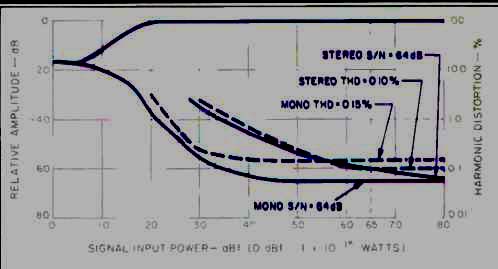
Fig. 1--Mono and stereo quieting and distortion characteristics, FM section.
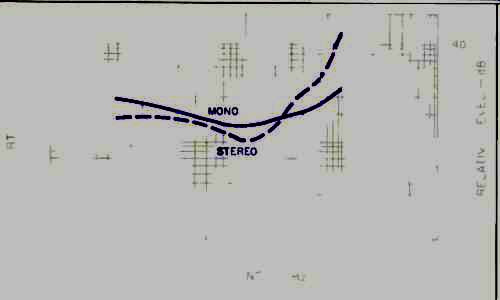
Fig. 2--THD vs. frequency, FM section.
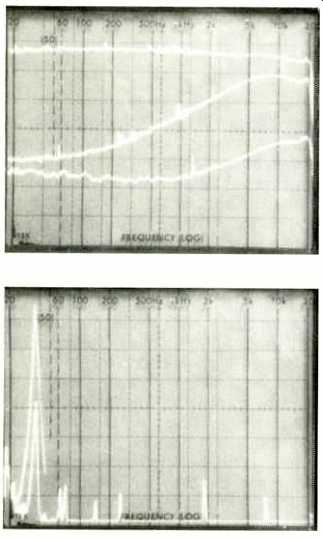
Fig. 3--FM frequency response (top trace), and separation vs. frequency
with blend circuit switched in (middle trace) and without blend (bottom trace).
Fig. 4--Crosstalk and distortion products resulting from 5-kHz modulation in one channel. (Vertical scale: 10 dB/div.)
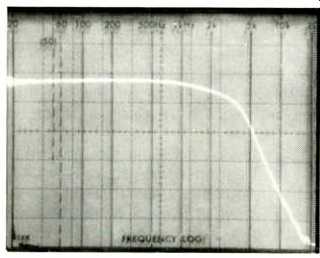
Fig. 5--Frequency response, AM section.
The top trace of Fig. 3 shows the FM stereo frequency response of the Gamma 30. Response was down about 1.5 dB at 50 Hz and at 10 kHz, but there was a slight rise in response above 10 kHz. (This rise is caused, no doubt, by a slight impedance mismatch or a buildup of tolerances in the 19-kHz low-pass filter circuitry that's supposed to attenuate the 19-kHz pilot carrier frequency during stereo reception.) The middle trace shows separation with the high-blend circuit activated. The bottom trace shows the full FM stereo separation characteristic, from 20 Hz to above 15 kHz. At mid-frequencies, separation measured 42 dB from the left channel to the right and 45 dB from the right channel to the left. At 100 Hz, separation was 44 dB (left to right) and 46 dB (right to left); at 10 kHz, separation measured 29 dB in both directions.
Figure 4 shows the available separation for a 5-kHz modulating signal-the difference in height between the two spikes at the left of the display; the vertical scale is 10 dB/ division. It also shows the crosstalk components that appear at the output of the unmodulated channel. Second- and third-harmonic components of the 5-kHz modulating signal on the opposite channel are visible in the oscilloscope photo, as are 19and 38-kHz subcarrier components located farther to the right.
Because of the high degree of residual noise in the output of this tuner at any signal level, it was not possible to obtain accurate measurements of spurious, image, and i.f. rejection ratios. AM suppression measured very close to the 50 dB claimed, alternate-channel selectivity was 62 dB, and capture ratio was approximately 2.0 dB. Surprisingly, the AM tuner section actually came closer to meeting its published specifications than did the FM section. AM frequency response, shown in Fig. 5, was reasonably flat to around 3.0 kHz, and signal-to-noise ratio for a strong AM signal measured 50 dB, as claimed. THD at 1 kHz measured 0.45%, and usable sensitivity was a shade better than the 300 µV/m claimed by Nikko.
Use and Listening Tests
The Gamma 30 is certainly easy enough to use. Both manual and automatic tuning modes performed as they should have, with the wide range of the muting control serving to limit the number of stations at which the automatic tuning would stop. Despite the less than optimal r.f. alignment in this sample, the i.f. section and the FM detector were well aligned, so that when my FM generator and the tuner display showed the same frequency, distortion was at its lowest point for that signal. This has not always been the case with frequency-synthesized tuners. I've tested many that yield lowest distortion when my generator is offset 10, 20, or in some cases even 40 to 50 kHz from the nominal frequency shown on the tuner's display. This type of misalignment was not in evidence on the Nikko sample, so that with strong incoming broadcast signals I did get inaudibly low distortion levels.
The positive attributes, however, cannot offset the fact that the tuner was not very sensitive (poor r.f. alignment). Nor can they offset the insufficient shielding of the signal circuits from the digital display and other noise-producing circuits, which caused that ever-present noise at 64 dB below full modulation. It is, of course, possible that this phenomenon was present only in the sample I tested, though I don't believe so. The Gamma 30 will certainly do for casual FM or AM listening, but I find it difficult to recommend to those seeking state-of-the-art FM reception.
-Leonard Feldman
-----------------
(Source: Audio magazine, Jan. 1987)
Also see:
Nikko Gamma I Stereo FM Tuner (May 1979)
= = = =